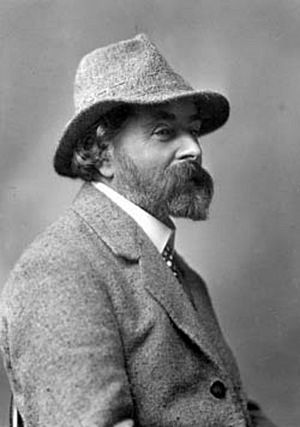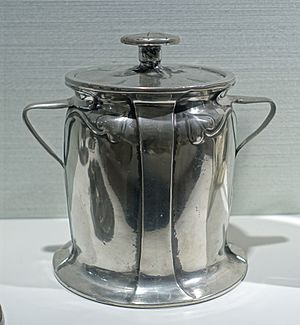Archibald Knox (designer) facts for kids
Quick facts for kids
Archibald Knox
|
|
|---|---|

Photo of Archibald Knox, c. 1900, at age 36
|
|
| Born | 9 April 1864 Cronkbourne, near Tromode, Isle of Man
|
| Died | 22 February 1933 (aged 68) |
| Known for | Design |
| Movement | Arts and Crafts Movement, Celtic Revival |
| Patron(s) | Arthur Lasenby Liberty |
Archibald Knox (born April 9, 1864, died February 22, 1933) was a famous designer from the Isle of Man. He is best known for creating many designs for the well-known department store, Liberty of London. His work was very popular and helped shape British and international design.
Knox's designs blended different art styles like the Arts and Crafts Movement, the Celtic Revival, and Art Nouveau. He is seen as a key figure in the "Modern Style" movement in Britain.
Even though his designs were very popular, many people didn't know his name. This was because Liberty kept their designers a secret. He created hundreds of items for Liberty, especially for their metal ranges called Tudric (pewter) and Cymric (precious metals). He even designed the gravestone for Liberty's founder, Arthur Lasenby Liberty.
Knox was talented in many areas. He designed silverware, pewterware, jewelry, inkwells, boxes, and even gravestones. He also created watercolours, graphic designs, and calligraphy. Some people think he made about 5,000 designs in his lifetime!
Contents
Early Life and Family
Archibald Knox was born in a small village called Cronkbourne on the Isle of Man. He was the fifth child in his family. His father, William Knox, was a skilled cabinet maker. In 1856, his parents moved to the Isle of Man from Scotland for a better life.
His father joined a company that made fishing nets and sailcloth. Later, William Knox started his own engineering business. Four of Archibald's brothers joined their father's company. Archibald, however, chose to follow his passion for art. His family's background in engineering might have influenced his designs, making them look like detailed blueprints.
Education and Early Interests
Knox went to St Barnabas Elementary School and then Douglas Grammar School. Growing up near the harbor in Douglas, Isle of Man, he started sketching the area as a teenager. In 1880, at age 16, he joined the new Douglas School of Art. The students there thought of themselves as "modern" artists. In 1889, he earned his Art Master's Certificate.
From a young age, Knox was very interested in the history of the Isle of Man and Celtic art. He especially loved the old Celtic and Norse stone crosses found on the island, which are from around 500 AD to 1200 AD. As a young teacher, he became friends with Canon John Quine, who was an expert in old things. They often went on trips to explore historical sites together.
Career as a Designer
Knox began teaching at Douglas School of Art in 1884 while he was still a student. He also worked with the architect Baillie Scott on some interior designs. In 1893, Knox wrote an article about the "Ancient Crosses in the Isle of Man" for a magazine called The Builder.
Around 1896 or 1897, Knox worked with the famous designer Christopher Dresser in London. In 1897, he started teaching at Redhill School of Art.
Later, in 1897, Knox began working for the Silver Studio. This studio created designs for Liberty. From 1900 to 1904, Knox returned to the Isle of Man. During this time, he created over 400 designs directly for Liberty of London. His most famous works were for the Cymric and Tudric metal collections. Liberty's catalog said that these designs were "completely breaking away from convention." This helped Liberty create a unique British version of Art Nouveau. Knox's work helped Liberty achieve its goal of making "useful and beautiful objects at prices within the reach of all."
Knox's Teaching Style
Knox had a very unique way of teaching art. He often told his students wise sayings about design. One of his main ideas was: "Aim at order, hope for beauty." He also wrote on the blackboard for new students: "Never be ordinary, better be nothing than that." Another saying was: "Art is in everything if we choose to put it there."
He had an innovative method of teaching. He collected 3,000 glass slides of different designs. He would show these to his students and encourage them to think about the design ideas behind each one. He also wanted them to consider if the design worked well for its purpose and the materials used.
One of his students, Winifred Tuckfield, explained his teaching. She said that instead of just copying old art, Knox showed slides of art from ancient times to modern days. He taught that art came from the joy of a worker using their tools. He even gave lectures on the homes, churches, and crosses of the Isle of Man, making his students love them.
Manx Culture and Art
Knox had a deep interest in nature, spirituality, and the history and art of the Isle of Man. He especially loved the early Celtic Christian churches there. He wrote a poem in 1913 called "Renshent" about an old Celtic chapel on the island.
Knox was part of a "Manx renaissance." This was a time when people rediscovered and celebrated the culture and history of the Isle of Man. This helped to strengthen the island's unique identity.
On Sundays, Knox would go to the countryside to paint. He would often wait for hours for the perfect light and weather. Then, he would quickly capture the scene in a watercolor painting. People said he was "The man who could paint the wind." He wrote that he painted places near his home, seeing something new each time in the colors and sky.
Many of his watercolor paintings of Manx scenes were given to the Manx Museum to be sold. This helped to fund the museum's expansion.
Later Years and Legacy
In 1912, Knox left his teaching job at Kingston School of Art after some criticism. About twenty of his students also left and formed the Knox Guild of Design and Crafts. Knox became the leader of this group. In 1913, he spent a year in the United States. After World War I, he taught art in schools on the Isle of Man until he passed away. He continued to create designs for publications, special illuminated texts, and gravestones on the island.
One of Knox's most important later works was an illuminated manuscript called 'The Deer's Cry'. This was a personal project he worked on for over 20 years. It was a detailed visual meditation on an old Irish prayer called 'Saint Patrick's Breastplate'. Each page was a complex, beautiful design that matched the words of the prayer.
Personal Life and Death
Archibald Knox was described as a modest and quiet person, almost like a monk. Some also said he could be a bit grumpy and stubborn. However, he had close friends, like Canon Quine. He was an active member of groups like the Isle of Man Antiquarian Society and the Freemasons. He also helped out at his local church.
Knox died in 1933 from heart failure. He was buried in Braddan Cemetery. His gravestone reads: "Archibald Knox. Artist. A humble servant of God in the ministry of the beautiful."
Legacy and Recognition
In 1975, the V&A Museum held an exhibition of Liberty's designs. This slowly helped more people learn about Archibald Knox and his amazing work.
A house called Cadran Cottage in Douglas, which Knox helped remodel around 1910, was recognized as a special historic building on the Isle of Man in 1996.
The first international exhibition of Knox's work traveled around the world from 1996 to 1998.
The Archibald Knox Society was started in 2006. This group aims to teach people all over the world about Knox's designs and his importance. They give lectures, publish journals, and help organize exhibitions.
To celebrate 150 years since Knox's birth, the Isle of Man Post Office released a set of 10 stamps featuring his designs in April 2014. Also in 2014, an exhibition about Knox's work was held at the House of Manannan on the Isle of Man. He was also honored at an art fair in London.
In 2019, Knox was added to the Manx Patriot's Roll of Honour. This was for his important role in bringing the island's culture back to life. A spokesperson said he "took the Isle of Man's Celtic and Norse art history and brought it back to life."
Gallery
See also
- Mannin (journal)













